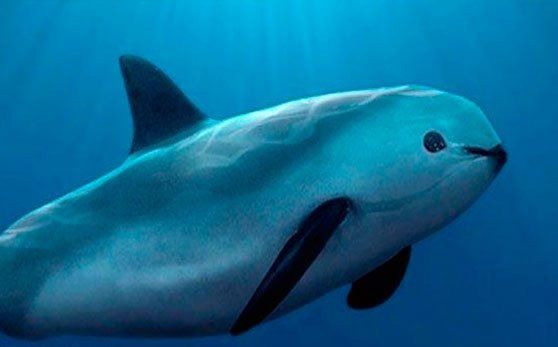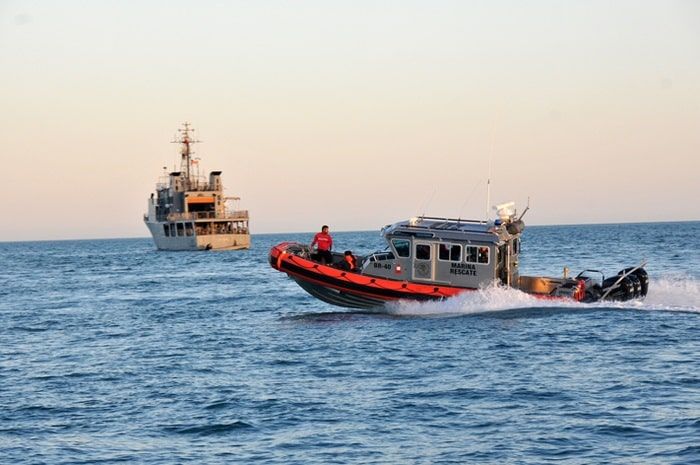Saving la vaquita, the world's smallest porpoise of the Gulf of California
The vaquita porpoise (Phocoena sinus), one of the smallest porpoises in the world, is a mammal native and exclusive to the Sea of Cortés and in danger.

It is one of the smallest marine mammals in the world, the only Mexican porpoise, a small cetacean. The vaquita (Phocoena sinus) inhabits a restricted region in the waters of the Gulf of California. Less than 40 years ago it was still unknown to science. Fishermen were disappointed to see it appear in their nets to catch totoabas, sharks, and other commercially valuable species. The meat and fat of this mammal do not have a pleasant taste, so the name "vaquita" is not due to the good taste of its fillets. The reason for this common name for such a small cetacean is not known.
More than four decades ago, biologists Kenneth S. Norris and William McFarland, from the United States, found on a beach in the northern Gulf of California some bone remains that belonged to a porpoise; upon studying them they confirmed that they were not from any known porpoise, and in 1958 they described Phocoena sinus as a new species of marine mammal; however, several years passed before complete specimens were collected. One of the first Mexican specialists who had the good fortune to observe these animals up close for the first time was the engineer Alejandro Robles, who tells us:
"We left on the boat at six in the morning. We were researching totoaba (Toloaba macdonaldi), a large fish endemic to the Gulf of California. We helped the fishermen pull the net and saw the first vaquita appear. I knew right away that it was not one of the known cetacean species, and then we found another one. On one hand, I was very proud to have collected the first specimens of this cetacean for science. On the other hand, I felt the sadness of knowing that we had in our hands two dead specimens of an endangered endemic species".
Since then, studies began to be carried out on the specimens that were eventually received by the researchers. It was determined that the size of adult vaquitas does not exceed 150 cm. They have a flattened head, and the eyes and mouth are surrounded by a characteristic dark shadow. They give birth to a single calf, and their gestation period is approximately 10 months, while lactation lasts 8 months, according to the professional thesis of biologist Mario A. Peralta, directed by Dr. Bernardo Villa Ramírez, researcher emeritus at UNAM. This thesis states that the highest number of births occurs in the cold months of January and February. Females reach maturity at six years of age and can have a calf every two years. This low reproductive rate is one of the most important factors when planning conservation actions.
Vaquitas feed on fish, small squid, shrimp, and crabs. Dr. Lloyd T. Findley and his collaborators analyzed the stomach contents of 24 vaquitas and found 19 different species; among them, two species of demic fish and one species of squid were the main components of their diet. On the other hand, M. en C. Héctor Pérez Cortés, from the Regional Fisheries Research Center of La Paz, in Baja California Sur, informed that he found 20 species in his study on the vaquita's diet, mostly fish and squid, and explains that there are differences between the vaquita's diet and that of the totoaba.
Some specialists have raised concerns that the species on which the vaquita feeds are affected by the alteration of the ecosystem, caused by the scarcity of water flowing from the Colorado River, after the construction, decades ago, of dams that diverted its flow. Others think that the negative influence of this lack of fresh water on the vaquita and its habitat is not too great. The northern Gulf and Colorado River delta, where the vaquita lives, is a habitat of great importance for its endemic species and a breeding site for certain species of commercial interest, such as sardines and shrimp. These waters are rich in nutrients, so food is abundant.
The vaquita only inhabits a restricted area in the northern Gulf of California.
The history of the vaquita is closely related to that of a large fish, the totoaba, because the small cetacean also falls into the gillnets used to catch the totoaba. Its fishery began around 1920, when the trade in the swim bladder of the females, which was used to prepare a gelatinous soup, common in Asian cuisine during the Chinese New Year holidays, became of interest. When these fisheries began, once the bladder was extracted, the remains of the totoabas were thrown away, so their bodies, more than a meter and a half long and weighing a hundred kilos, were eaten by seabirds, coyotes, and other animals, or simply decomposed on the coasts.
Such waste continued for some time until the trade of their meat gained importance. Advances in fishing techniques, on the one hand, and on the other, the proliferation of outboard motors in the 1940s, led first to a significant increase in catches and, later, to their decline, so that in the 1970s it was necessary to declare a total ban on this species.
But the fishery did not cease with the ban, and even if it had, the damage had already been done. The totoaba was in danger of extinction, and the vaquita along with it. It is claimed that today, decades after the total ban on totoaba, illegal fishing continues. Many deaths of the vaquita are due to illegal nets set for the capture of totoaba. As illegal totoaba fishing persisted, a decree was issued in 1992 prohibiting the use of nets with mesh sizes larger than 25 cm, which were used to catch this large fish and in which the vaquita became entangled. However, gill nets with a smaller mesh size also pose a danger to the vaquita, which has been caught with the shark, ray, corvina, and mackerel fishing nets, as well as with shrimp trawls.

On June 10, 1993, the upper Gulf of California and the Colorado River delta, where the vaquita lives, were declared a biosphere reserve. Although fishing for marine mammals has been prohibited by Mexican law since 1992, many continue to die from current artisanal fishing methods.
Some scientists consider that another of the vaquita's problems is its reduced genetic variability. Biologist Lorenzo Rojas explains that the general objective of the research is to evaluate the genetic variability of the vaquita using molecular biology techniques. He adds: "In our research in collaboration with Dr. Patricia Rosel, we found that the genetic variation in the most variable region of the mitochondrial DNA is equal to zero. In other words, about this molecule, one vaquita would be the same as another.
The vaquita has the most limited distribution of all cetaceans.
It is generally recognized that when a population goes through a stage of population size contraction, or 'bottleneck', there is a reduction in genetic variability because genes are being lost from the population. This is due to random changes in gene frequencies. Likewise, variability is also lost due to inbreeding, which is reproduction between close relatives. These two phenomena can lead to an inbreeding depression that favors a loss of vigor in the species, in terms of developmental deficiencies, low fertility, and limited survival.
"However, our results with mitochondrial DNA so far only tell us that the vaquita population went through a 'founder effect' - which is the formation of a new species or population from a few founders - or a 'bottleneck' or both. That is, we cannot establish a direct relationship between genetic variability in this DNA molecule, vaquita genetic health, high inbreeding, and inbreeding depression".
On the other hand, Dr. Bernardo Villa and his collaborators from the Institute of Biology of the UNAM recorded the presence of a bony protuberance in the third metacarpal of the pectoral fins of the vaquita. Biologist Loel G. Ortega Ortiz made a more detailed description of the pectoral fins of the vaquita, and observed the presence of six toes on them, while in all other cetaceans the normal number of toes is five. Although the presence of extra toes has been recorded in some cetaceans, this phenomenon is considered a malformation. In the case of the vaquita, the presence of six toes is a characteristic that is present in all individuals, which is why some scientists consider that it could be a consequence of the "bottleneck" in which the population finds itself. More recently, M. en C. Jorge Torre discovered other malformations in the vertebrae of some vaquita specimens.
In the Red Book of the International Union for Conservation of Nature, the vaquita is considered a threatened species. It is also included in Appendix I of the Convention on International Trade in Endangered and Threatened Species (CITES). The Mexican Official Standard, which determines the species and subspecies of wild and aquatic flora and fauna in danger of extinction, rare and those subject to special protection, and establishes specifications for their protection, classifies the vaquita as an endangered species.
The vaquita is an endemic species in danger of extinction. Currently, only a few hundred specimens survive.
Opinions vary on the abundance of the vaquita, but almost all agree that they do not exceed a few hundred individuals. These mammals are very difficult to observe in their habitat. Silvia Manzanilla, from UNAM's Ecology Center, in a paper soon to be published in the journal Marine Mammal Science, reports that during aerial surveys conducted in the summer, as part of her doctoral thesis work on this species, she reported groups of vaquita feeding in the channels of the Colorado River delta, as well as a group of 12 vaquitas resting in front of Tornillal, in the Gulf of Santa Clara, Sonora.
The establishment of the Upper Gulf of California and Colorado River Delta Biosphere Reserve was an important step for vaquita conservation. Now it is necessary to carry out good management of this area to increase the chances of survival of this special porpoise. There are recommendations to reduce the pressure on the fishing resources in the area and to change certain types of fishing techniques, which would reduce the chances of vaquita falling into the nets.
Other employment options are being studied for the region's fishermen, such as shrimp and oyster aquaculture, ecotourism, agriculture, maquiladora industries, including packaging and canning of marine products, etc. But it is necessary to establish very well the strategies to carry out the implementation of any production process in the region, to avoid long-term alterations of the marine and coastal environment.
The vaquita is the only species of marine mammal endemic to the Gulf of California, probably the least known cetacean in the world, and the most endangered. Mexico has proposed to the International Whaling Commission a recovery plan for the vaquita, which contemplates the formation of an international committee of advisors, made up of renowned scientists, who will provide advice and proposals for the development of the plan.
Sources: Emma Romeu, Biodiversitas (8) Mexico: CONABIO, SEMARNAT




